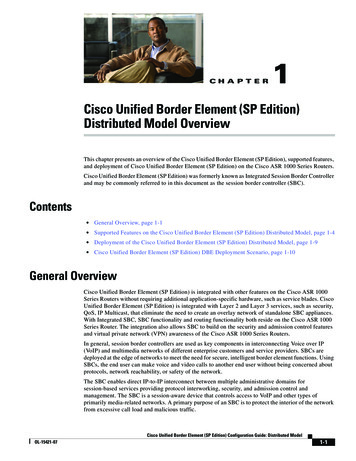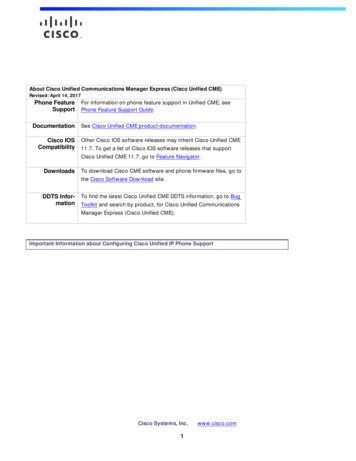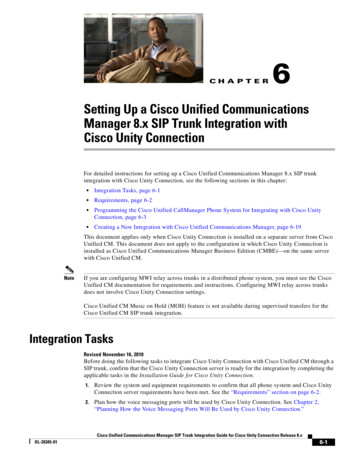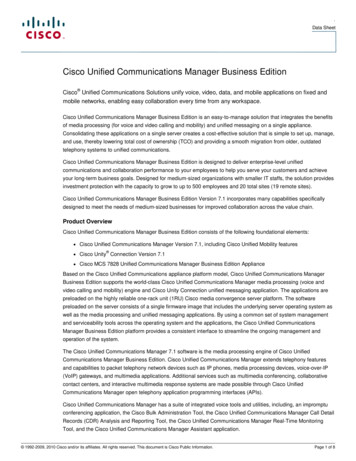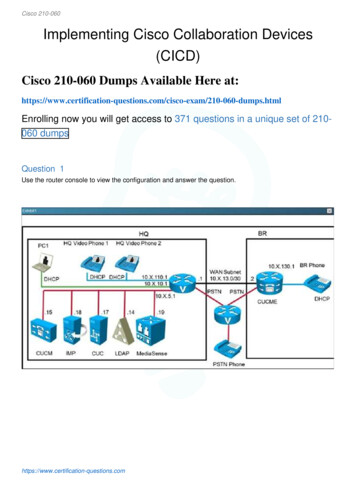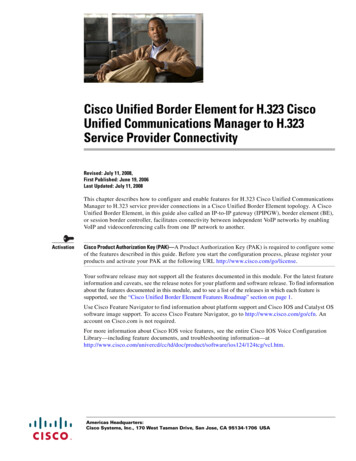
Transcription
Cisco Unified Border Element for H.323 CiscoUnified Communications Manager to H.323Service Provider ConnectivityRevised: July 11, 2008,First Published: June 19, 2006Last Updated: July 11, 2008This chapter describes how to configure and enable features for H.323 Cisco Unified CommunicationsManager to H.323 service provider connections in a Cisco Unified Border Element topology. A CiscoUnified Border Element, in this guide also called an IP-to-IP gateway (IPIPGW), border element (BE),or session border controller, facilitates connectivity between independent VoIP networks by enablingVoIP and videoconferencing calls from one IP network to another.ActivationCisco Product Authorization Key (PAK)—A Product Authorization Key (PAK) is required to configure someof the features described in this guide. Before you start the configuration process, please register yourproducts and activate your PAK at the following URL http://www.cisco.com/go/license.Your software release may not support all the features documented in this module. For the latest featureinformation and caveats, see the release notes for your platform and software release. To find informationabout the features documented in this module, and to see a list of the releases in which each feature issupported, see the “Cisco Unified Border Element Features Roadmap” section on page 1.Use Cisco Feature Navigator to find information about platform support and Cisco IOS and Catalyst OSsoftware image support. To access Cisco Feature Navigator, go to http://www.cisco.com/go/cfn. Anaccount on Cisco.com is not required.For more information about Cisco IOS voice features, see the entire Cisco IOS Voice ConfigurationLibrary—including feature documents, and troubleshooting cas Headquarters:Cisco Systems, Inc., 170 West Tasman Drive, San Jose, CA 95134-1706 USA
Cisco Unified Border Element for H.323 Cisco Unified Communications Manager to H.323 Service ProviderContentsContents Prerequisites for Cisco Unified Border Element for H.323 Cisco Unified Communications Managerto H.323 Service Provider Connectivity, page 318 Restrictions for Cisco Unified Border Element for H.323 Cisco Unified Communications Managerto H.323 Service Provider Connectivity, page 319 Information About Cisco Unified Border Element for H.323 Cisco Unified CommunicationsManager to H.323 Service Provider Connectivity, page 320 How to Configure Cisco Unified Border Elements for H.323 Cisco Unified CommunicationsManager to H.323 Service Provider Connectivity., page 320 Configuration Examples for Cisco Unified Border Element for H.323 Cisco UnifiedCommunications Manager to H.323 Service Provider Connectivity, page 331 Additional References, page 334 Feature Information for Cisco Unified Border Element for H.323 Cisco Unified CommunicationsManager to H.323 Service Provider Connectivity, page 338Prerequisites for Cisco Unified Border Element for H.323 CiscoUnified Communications Manager to H.323 Service ProviderConnectivityActivationCisco Product Authorization Key (PAK)—A Product Authorization Key (PAK) is required to configure someof the features described in this guide. Before you start the configuration process, please register yourproducts and activate your PAK at the following URL http://www.cisco.com/go/license. Perform the prerequisites listed in the “Prerequisites for Cisco Unified Border ElementConfiguration” section on page 22 in this guide. Perform basic H.323 gateway configuration. Perform basic H.323 gatekeeper configuration.NoteFor configuration instructions, see the “Configuring H.323 Gateways” and “Configuring H.323Gatekeepers” chapters of the Cisco IOS Voice, Video, and Fax Configuration Guide,Release 12.2.In order to interconnect with an Cisco UBE, configure Cisco Unified Communications Manager with thefollowing: NoteCisco Unified Communications Manager 3.0 or later release.The Cisco Unified Communications Manager 4.1 has a SIP trunk towards the Cisco UBE in anH.323-to-SIP or a SIP-to-SIP network.Cisco Unified Border Element Configuration Guide318
Cisco Unified Border Element for H.323 Cisco Unified Communications Manager to H.323 Service ProviderRestrictions for Cisco Unified Border Element for H.323 Cisco Unified Communications Manager to H.323 Service Media termination point (MTP)—Enables the Cisco Unified Communications Manager to extendsupplementary services, such as hold and transfer, to calls that are routed through an H.323 endpointor an H.323 gateway.– Cisco IOS Release 12.4(4)T and earlier releases: MTP is required.– Cisco IOS Release 12.4(6)T and later releases: MTP is optional for H.323-to-H.323 calls.Note Intercluster Trunk (ICT)—An H.323 connection that enables multiple Cisco UnifiedCommunications Manager systems to be connected over an IP cloud. Configure Cisco Unified Communications Manager in gateway mode while interoperating with theCisco Unified Border Element. During ICT configuration on the Cisco Unified Communications Manager, you are asked to enterthe IP address of the remote Cisco Unified Communications Manager to which the ICT connects.Do not use this IP address. Instead, enter the IP address of the Cisco UBE. For more information on MTP, ICT, and Cisco Unified Communications Manager configuration, seethe Cisco Unified Communications Manager documentation s556/products installation and configurationguides list.htmlRestrictions for Cisco Unified Border Element for H.323 CiscoUnified Communications Manager to H.323 Service ProviderConnectivity This functionality is enabled by default in Cisco IOS images that support the Cisco UBE, so you donot need to enter the commands that follow. However, the commands do appear in software and areexplained here for informational purposes. Cisco Unified Communications Manager compatibility is as follows:– Cisco IOS Release 12.3(7)T and later releases: You must enable Cisco UnifiedCommunications Manager compatibility on the Cisco UBE. The call start interwork command only supports interwork between fast-start and slow-start. Itshould not be used in situations where fast-start to fast-start or slow-start to slow-start calls arepossible. When call start interwork is configured, both incoming and outgoing dial-peer need to have aspecific codec configured. Ringback to the transferee is not supported by the Cisco Unified Border Element Software for callsblind call transferred between Cisco Unified Communications Manager and Cisco UnifiedCommunications Express.Cisco Unified Border Element Configuration Guide319
Cisco Unified Border Element for H.323 Cisco Unified Communications Manager to H.323 Service ProviderInformation About Cisco Unified Border Element for H.323 Cisco Unified Communications Manager to H.323 ServiceInformation About Cisco Unified Border Element for H.323 CiscoUnified Communications Manager to H.323 Service ProviderConnectivityFor more information on Cisco Unified Communications Manager configuration, see the Cisco UnifiedCommunications Manager documentation s556/products installation and configuration guides list.htmlHow to Configure Cisco Unified Border Elements for H.323 CiscoUnified Communications Manager to H.323 Service ProviderConnectivity.The section contains the following tasks: Configuring Cisco Unified Border Element to Transport Calls With Cisco Unified Cisco UnifiedCommunications Manager, page 320 Configuring DTMF Relay Digit-Drop on an Cisco Unified Border Element with Cisco UnifiedCommunications Manager, page 323 Configuring H.323 Calling Name Display, page 324Configuring Cisco Unified Border Element to Transport Calls With Cisco UnifiedCisco Unified Communications ManagerTo configure the Cisco UBE to transport calls to and from Cisco Unified Communications Manager,perform the steps in this section.PrerequisitesConfigure Cisco Unified Communications Manager with the following: Media termination point (MTP)—Enables Cisco Unified Communications Manager to extendsupplementary services, such as hold and transfer, to calls that are routed through an H.323 endpointor an H.323 gateway. Cisco IOS Release 12.4(6)T and later releases: No MTP is optional. Intercluster trunk (ICT)—An H.323 connection that enables multiple Cisco UnifiedCommunications Manager systems to be connected over an IP cloud.NoteDuring ICT configuration, you are asked to enter the IP address of the remote Cisco UnifiedCommunications Manager to which the ICT connects. Do not use this IP address. Instead,enter the IP address of the Cisco UBE.Cisco Unified Border Element Configuration Guide320
Cisco Unified Border Element for H.323 Cisco Unified Communications Manager to H.323 Service ProviderHow to Configure Cisco Unified Border Elements for H.323 Cisco Unified Communications Manager to H.323 ServiceRestrictionsCisco UBE does not support call preservation. If an Cisco UBE is located between a gateway and a CiscoUnified Communications Manager that have call preservation configured and the Cisco UBE isconfigured with media flow-around, calls will be preserved on the gateway when the Cisco UBE's IPinterface becomes inaccessible due to a network issue or a reload. In this case, call preservation behavioron the gateway will be the same as the case where there is no Cisco UBE between the gateway and theCisco Unified Communications Manager. Calls that are “held” will not be preserved as the Cisco UBEpasses the nonstandard “do not preserve” indication sent in the Notify message from Cisco UnifiedCommunications Manager to the gateway.SUMMARY STEPS1.enable2.configure terminal3.voice service voip4.h3235.h225 h245-address6.ccm-compatible7.exitDETAILED STEPSStep 1Command or ActionPurposeenableEnables privileged EXEC mode. Enter your password if prompted.Example:Router enableStep 2configure terminalEnters global configuration mode.Example:Router# configure terminalStep 3voice service voipEnters VoIP voice-service configuration mode.Example:Router(config)# voice service voipStep 4h323Enters H.323 voice-service configuration mode.Example:Router(conf-voi-serv)# h323Cisco Unified Border Element Configuration Guide321
Cisco Unified Border Element for H.323 Cisco Unified Communications Manager to H.323 Service ProviderHow to Configure Cisco Unified Border Elements for H.323 Cisco Unified Communications Manager to H.323 ServiceStep 5Command or ActionPurposeh225 h245-address {sync facility progress}Enables H.225 and H.245 signaling. Keywords are asfollows:Example: sync—Synchronized H.245 address reporting.Timing of H.245 messages is controlled byendpoints, not by the Cisco UBE. facility—Cisco UBE sends a message to instruct theoriginating Cisco Unified Communications Managerto begin H.245 procedures on call start. progress—Cisco UBE sends a Progress message thatincludes the H.245 address and a Progress Indicatorvalue of 0x03.Router(config-serv-h323)# h225 h245-addressStep 6Enables Cisco Unified CommunicationsManager-compatible -h323)# ccm-compatibleStep 7Exits the current mode.exitExample:Router(config-serv-h323)# exitTroubleshooting TipsIn the event that calls setup from Cisco Unified Communications Manager to Cisco Unified CallManagerExpress have no audio, verify the following: Interwork between Fast Start and Slow Start is not supported by the call start interwork command. When call start interwork is configured, both incoming and outgoing dial-peer need to have aspecific codec configured.Cisco Unified Border Element Configuration Guide322
Cisco Unified Border Element for H.323 Cisco Unified Communications Manager to H.323 Service ProviderHow to Configure Cisco Unified Border Elements for H.323 Cisco Unified Communications Manager to H.323 ServiceConfiguring DTMF Relay Digit-Drop on an Cisco Unified Border Element withCisco Unified Communications ManagerTo avoid sending both in-band and out-of band tones to the outgoing leg when sending Cisco UBE callsin-band (rtp-nte) to out-of band (h245-alphanumeric), configure the dtmf-relay rtp-nte digit-dropcommand on the incoming SIP dial-peer. On the H.323 side configure either dtmf-relayh245-alphanumeric or dtmf-relay h245-signal command. This feature may also be used forH.323-to-SIP, and H.323-to-H.323 calls.NoteFor a SIP (rtp-nte) to H.323 (h245-alphanumeric) via Cisco UBE call, if any RTP-NTE packets are sentbefore the H.323 Endpoint answers the call, the dual-tone multifrequency (DTMF) signal is not audibleon a terminating gateway (TGW)Perform the following task to configure DTMF relay digit drop on an Cisco UBE with Cisco UnifiedCommunications Manager.Restrictions Configuring the digit-drop command is required for interworking between OOB and RTP NTE. Digit-drop for in-band rtp-nte DTMF conversion requiring a transcoder is not supported.1.enable2.configure terminal3.dial-peer voice tag voip4.dtmf-relay [cisco-rtp] [h245-alphanumeric] [h245-signal][rtp-nte [digit-drop]]5.exitSUMMARY STEPSDETAILED STEPSStep 1Command or ActionPurposeenableEnables privileged EXEC mode. Enter your password if prompted.Example:Router enableStep 2configure terminalEnters global configuration mode.Example:Router# configure terminalStep 3dial-peer voice tag voipEnters dial-peer voice configuration mode for thespecified VoIP dial peer.Example:Router(config)# dial-peer voice 2 voipCisco Unified Border Element Configuration Guide323
Cisco Unified Border Element for H.323 Cisco Unified Communications Manager to H.323 Service ProviderHow to Configure Cisco Unified Border Elements for H.323 Cisco Unified Communications Manager to H.323 ServiceStep 4Command or ActionPurposedtmf-relay [cisco-rtp][h245-alphanumeric][h245-signal] [rtp-nte[digit-drop]]Forwards DTMF tones. Keywords are as follows:Example:Router (config-dial-peer)# dtmf-relay rtp-ntedigit-drop cisco-rtp—Forwards DTMF tones by using RTPwith a Cisco-proprietary payload type. h245-alphanumeric—Forwards DTMF tones byusing the H.245 alphanumeric method. h245-signal—Forwards DTMF tones by using theH.245 signal UII method. rtp-nte—Forwards DTMF tones by using Real-TimeTransport Protocol (RTP) with the Named TelephoneEvent (NTE) payload type. digit-drop—Passes digits out-of-band; and dropsin-band digits.NoteStep 5The digit-drop keyword is available only whenthe rtp-nte keyword is configured.Exits the current mode.exitExample:Router(config-dial-peer)# exitExamplesThe following example shows DTMF-Relay digits configured to avoid sending both in-band andout-of-band tones to the outgoing leg in an Cisco UBE:.dial-peer voice 1 voipdtmf-relay h245-alphanumeric rtp-nte digit-drop.Troubleshooting tips The debug output will show that the H245 out of band messages are sent to the TGW. However, entryof the digits are not audible on the phone.Configuring H.323 Calling Name DisplayThe H.323 Calling Name Display feature provides a configurable option on the Cisco gateway to sendthe calling name received in Q931 Facility messages in the Display IE of setup message or Display IEof H.225 Notify messages to the Cisco Unified Communications Manager so that it can interpret thecalling name and display it on Cisco IP Phones.Cisco Unified Border Element Configuration Guide324
Cisco Unified Border Element for H.323 Cisco Unified Communications Manager to H.323 Service ProviderHow to Configure Cisco Unified Border Elements for H.323 Cisco Unified Communications Manager to H.323 ServicePrerequisites This software operation is transparent to Cisco Unified Communications Manager and works withall releases, although Cisco Unified Communications Manager 4.2 or later is recommended The isdn supp-service name calling command must be configured under isdn D-channel for theH.323 Calling Name Display feature to work. It is recommended that you configure the signaling forward unconditional command on theoutgoing gateway. This ensures that the outgoing H225 message has both the raw message and theGeneric Transparency Descriptor (GTD). To configure the H.323 Calling Name Display feature under the voice class configuration, completeyour dial-peer configuration first. Additional dial peer configuration information is available in theDial Peer Configuration on Voice Gateway Routers Guide at the following t/software/ios123/123cgcr/vvfax c/int c/dpeer c/dp confg.htm When a Cisco gateway is connected to ISDN switch that sends the name-to-follow in Q931 Setupmessage, and the calling name in subsequent Q931 Facility message, It is recommended that youconfigure h225 timeout ntf command to buffer the setup message for the necessary interval. Calling name handling for various messages under ISDN, while interoperating with different switchtypes is not supported.RestrictionsInformation About H.323 Calling Name DisplayCalling name display information can be populated in ISDN messages in the Display InformationElement (IE) of a Q.931 Setup or Notify message, or in the Facility IE of a Q.931 Setup or Facilitymessage. The Cisco IOS gateway places this information into the same field of the corresponding H.323message.Cisco Unified Communications Manager (Cisco Unified CM) interprets calling name information (forpurposes of name display on IP phones registered with Unified CM only in the Display IE of the H.323Setup and Notify messages. Name display information delivered in an H.323 Facility message is notinterpreted by Cisco Unified CM. Some ISDN switch types (for example, NI2) send a “name-to-follow”indication in the Q.931 Setup message and deliver the calling name subsequently in the Facility IE of aQ.931 Facility message. When a Cisco IOS gateway is connected to such an ISDN switch andinteroperating with Cisco Unified CM by using the H.323 protocol, Cisco Unified CM is unable todisplay calling names on IP phones.Beginning with Cisco IOS Release 12.4(11)XW, two new modes of operation are introduced onCisco IOS gateway:H.323 Calling Name Display Without BufferingWhen a Q.931 Setup message with a "name-to-follow" indication is received from an ISDN switch, anH.323 Setup message with no name information is sent to Cisco Unified CM. When the subsequentQ.931 Facility message is received with the calling name information, the message is mapped by thegateway to an H.225 Notify message with the Display IE populated with the calling name, so that theCisco Unified CM can interpret the message correctly and display the calling name on the IP Phone.Cisco Unified Border Element Configuration Guide325
Cisco Unified Border Element for H.323 Cisco Unified Communications Manager to H.323 Service ProviderHow to Configure Cisco Unified Border Elements for H.323 Cisco Unified Communications Manager to H.323 ServiceH.323 Calling Name Display With BufferingWhen a Q.931 Setup message with a “name-to-follow” indication is received from an ISDN switch, thegateway can buffer the setup message until the subsequent Q.931 Facility message with calling nameinformation is received. The name information from the Q.931 Facility message is now placed into theH.323 Setup message Display IE and sent to Cisco Unified CM. If the buffer timer expires before theQ.931 Facility message is received, a H.323 Setup is sent with no name information and, if itsubsequently arrives, the information is sent by using an H.225 Notify message.How to Enable H.323 Calling Name DisplayH.323 Calling name display is configured with or without buffering. This section contains the followingsubsections: Configuring H.323 Calling Name Display Without Buffering, page 326 Configuring H.323 Calling Name Display With Buffering, page 329Configuring H.323 Calling Name Display Without BufferingTo enable the H.323 Calling Name Display feature without buffering for ISDN trunks that use theFacility message to deliver Name Display information, perform the steps in this section. This sectioncontains the following subsections Configuring H.323 Calling Name Display Without Buffering at the Voice Service Level, page 326 Configuring H.323 Calling Name Display Without Buffering at the Voice Class Level, page 327Configuring H.323 Calling Name Display Without Buffering at the Voice Service LevelTo configure H.323 Calling Name Display without buffering at the voice service level, perform the stepsin this section:SUMMARY STEPS1.enable2.configure terminal3.voice service voip4.h3235.h225 display-ie ccm-compatibleCisco Unified Border Element Configuration Guide326
Cisco Unified Border Element for H.323 Cisco Unified Communications Manager to H.323 Service ProviderHow to Configure Cisco Unified Border Elements for H.323 Cisco Unified Communications Manager to H.323 ServiceDETAILED STEPSStep 1Command or ActionPurposeenableEnables privileged EXEC mode. Enter your password if prompted.Example:Router enableStep 2configure terminalEnters global configuration mode.Example:Router# configure terminalStep 3voice service voipEnters VoIP voice-service configuration mode.Example:Router(config)# voice service voipStep 4Enters H.323 voice-service configuration modeh323Example:Router(conf-voi-serv)# h323Step 5h225 display-ie ccm-compatibleInterprets the H.323 Notify Display IE so that the IPPhone can display the calling name on the IP Phone.Example:Router(conf-voi-serv)# h225 display-ieccm-compatibleConfiguring H.323 Calling Name Display Without Buffering at the Voice Class LevelBehavior and configuration will vary based on the configuration mode the command is configured. Whenthis CLI is configured under voice class: When the h225 display-ie ccm-compatible command is configured at the global level, and h225display-ie ccm-compatible system command is configured at voice class level under dial-peer, bothfacility and notify messages are sent. When the h225 display-ie ccm-compatible command is not configured at global level, and the h225display-ie ccm-compatible system command is configured at voice class level under dial-peer, onlythe facility message is sent. The configured command is visible in the show running-configuration output under voice class. Configuring the no h225 display-ie ccm-compatible system command in voice class configurationmode, the command that is configured under voice class takes precedence. Even when the no h225display-ie ccm-compatible system command is configured under voice class and the h225display-ie ccm-compatible command is configured under voice service voip, the gateway will notsend the H225 Notify message received, and the calling name does not display on the IP Phone.Use the no version to disable sending H225 Notify message on a particular VoIP dial-peer. The noform of the command is shown under voice class in the show running-configuration.Cisco Unified Border Element Configuration Guide327
Cisco Unified Border Element for H.323 Cisco Unified Communications Manager to H.323 Service ProviderHow to Configure Cisco Unified Border Elements for H.323 Cisco Unified Communications Manager to H.323 ServicePrerequisitesTo configure the H.323 Calling Name Display feature under the voice class configuration, complete yourdial-peer configuration first. Additional dial peer configuration information is available in the Dial PeerConfiguration on Voice Gateway Routers Guide at the following t/software/ios123/123cgcr/vvfax c/int c/dpeer c/dp confg.htmSUMMARY STEPS1.enable2.configure terminal3.voice service voip4.voice class h323 tag5.h225 display-ie ccm-compatibleDETAILED STEPSStep 1Command or ActionPurposeenableEnables privileged EXEC mode. Enter your password if prompted.Example:Router enableStep 2configure terminalEnters global configuration mode.Example:Router# configure terminalStep 3voice service voipEnters VoIP voice-service configuration mode.Example:Router(config)# voice service voipStep 4voice class h323 tagEnters H.323 voice-service configuration modeExample:Router(conf-voi-serv)# voice class h323 1Step 5h225 display-ie ccm-compatibleExample:Router(conf-voi-serv)# h225 display-ieccm-compatibleCisco Unified Border Element Configuration Guide328Interprets the H.323 Notify Display IE so that the IPPhone can display the calling name on the IP Phone.
Cisco Unified Border Element for H.323 Cisco Unified Communications Manager to H.323 Service ProviderHow to Configure Cisco Unified Border Elements for H.323 Cisco Unified Communications Manager to H.323 ServiceConfiguring H.323 Calling Name Display With BufferingTo enable the H.323 Calling Name Display feature with buffering for ISDN trunks that use the Facilitymessage to deliver Name Display information, perform the steps in this section. This section containsthe following subsections Configuring H.323 Calling Name Display with Buffering at the Voice Service Level, page 329 Configuring H.323 Calling Name Display with Buffering at the Voice Class Level, page 330Configuring H.323 Calling Name Display with Buffering at the Voice Service LevelTo configure H.323 calling name display at the voice service level, perform the steps in this section.SUMMARY STEPS1.enable2.configure terminal3.voice service voip4.h3235.h225 timeout ntf milliseconds6.h225 display-ie ccm-compatibleDETAILED STEPSStep 1Command or ActionPurposeenableEnables privileged EXEC mode. Enter your password if prompted.Example:Router enableStep 2configure terminalEnters global configuration mode.Example:Router# configure terminalStep 3voice service voipEnters VoIP voice-service configuration mode.Example:Router(config)# voice service voipStep 4h323Enters the H.323 voice-service configuration mode.Example:Router(conf-voi-serv)# h323Cisco Unified Border Element Configuration Guide329
Cisco Unified Border Element for H.323 Cisco Unified Communications Manager to H.323 Service ProviderHow to Configure Cisco Unified Border Elements for H.323 Cisco Unified Communications Manager to H.323 ServiceStep 5Command or ActionPurposeh225 timeout ntf millisecondsBuffers the setup message until the Q.931 Facilitymessage with calling name information is received.Range is 50-5000 milliseconds.Example:Router#(conf-voi-h323)# h225 timeout ntf 300Step 6h225 display-ie ccm-compatibleInterprets the H.323 Notify Display IE so that the IPPhone can display the calling name on the IP Phone.Example:Router#(conf-if)# h225 display-ie ccm-compatibleConfiguring H.323 Calling Name Display with Buffering at the Voice Class LevelTo configure H.323 Calling Name Display at the voice class level, perform the steps in this section.PrerequisitesTo configure the H.323 Calling Name Display feature under the voice class configuration, complete yourdial-peer configuration first. Additional dial peer configuration information is available in the Dial PeerConfiguration on Voice Gateway Routers Guide at the following t/software/ios123/123cgcr/vvfax c/int c/dpeer c/dp confg.htmSUMMARY STEPS1.enable2.configure terminal3.voice class h323 tag4.h225 display-ie ccm-compatible system5.h225 timeout ntf millisecondsDETAILED STEPSStep 1Command or ActionPurposeenableEnables privileged EXEC mode. Enter your password if prompted.Example:Router enableStep 2configure terminalEnters global configuration mode.Example:Router# configure terminalStep 3voice class h323 tagExample:Router(config)# voice service voipCisco Unified Border Element Configuration Guide330Creates an H.323 voice class that is independent of a dialpeer and can be used on multiple dial peers. Range isfrom 1 to 10000. There is no default value.
Cisco Unified Border Element for H.323 Cisco Unified Communications Manager to H.323 Service ProviderConfiguration Examples for Cisco Unified Border Element for H.323 Cisco Unified Communications Manager to H.323Step 4Command or ActionPurposeh225 display-ie ccm-compatible systemInterprets the H.323 Notify Display IE so that the IPPhone can display the calling name on the IP Phone.Example:Router#(conf-voi-h323)# h225 display-ieccm-compatible systemStep 5h225 timeout ntf millisecondsExample:Router#(conf-voi-h323)# h225 timeout ntf 300Buffers the setup message until the Q.931Facilitymessage with calling name information is received.Range is 50-5000 milliseconds.NoteIn the event the facility is received before thetimer expires, the gateway will stop the buffertimer, extract the relevant information and send itto terming endpoint.Troubleshooting Tips Enable debug isdn q931 to see the calling name coming into the GW in ISDN messages. Enable debug h225 q931 to see the calling name sent out by GW in H225 messages.Configuration Examples for Cisco Unified Border Element forH.323 Cisco Unified Communications Manager to H.323 ServiceProvider ConnectivityThe following section contains configuration examples for the following: Cisco Unified Border Element and Cisco Unified Communications Manager: ExampleCisco Unified Border Element and Cisco Unified Communications Manager:ExampleCisco UBE interconnects with Cisco Unified Communications Manager, providing a billing and networkdemarcation point and enabling service providers to transport calls to and from enterprise customers whouse Cisco Unified Communications Manager.H.245 handles end-to-end control messages between H.323 entities. H.245 procedures establish logicalchannels for transmission of audio and control channel information and are used to negotiate channelusage, flow control, and capabilities exchange messages.In releases earlier than Cisco IOS Release 12.3(1), the Cisco UBE responded to an incoming slow-startSETUP message with a CALLPROC message containing an H.245 address. This behavior isincompatible with the manner in which Cisco Unified Communications Manager handles H.245messages. With Cisco IOS Release 12.3(1) and later releases, the Cisco UBE delays the reporting oforiginating-side H.245 address until a terminating-side H.245 address is received. Thus H.245procedures
Note The Cisco Unified Communications Manager 4.1 has a SIP trunk towards the Cisco UBE in an . In the event that calls setup from Cisco Unified Communications Manager to Cisco Unified CallManager Express have no audio, verify the following: . RFC 3325 Private Extensions to the Session Initiation Protocol (SIP) for Asserted Identity within .
